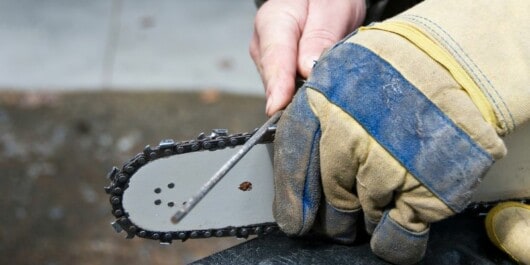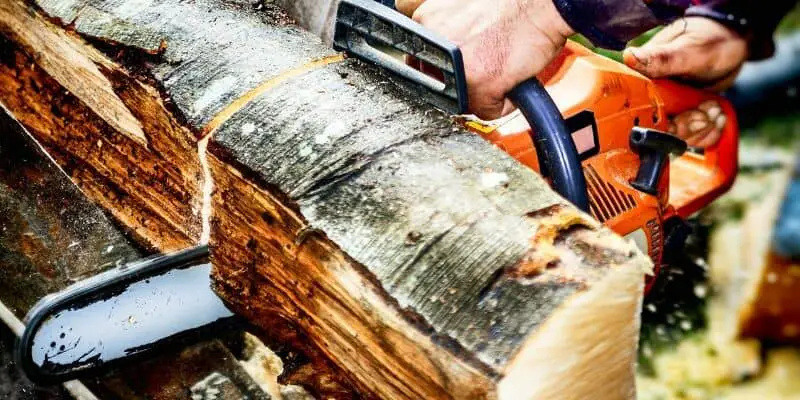Have you noticed your chainsaw cutting crooked, but don’t know why this is happening? If yes, was your answer, then you are definitely in the right place.
Why does my chainsaw cut crooked is a question that many chainsaw users have from time to time. This usually happens due to a number of reasons, including an inadequately sharpened chainsaw chain, inconsistent chain, uneven sharpness, unequal top plate, a bent bar, uneven cutting teeth, and more. While there are simple ways to resolve these issues, you can also make sure your chainsaw doesn’t cut crooked by regularly maintaining it.
In this article, you will get to know all about chainsaws cutting crooked, why does my chainsaw cut crooked, how you can resolve this issue of your chainsaw cutting crooked, and more. Continue reading to get all the answers that you’re looking for.
Is your chainsaw cutting crooked?
Chainsaws are strong power tools that make splitting wood, felling trees, and chopping firewood almost straightforward. However, even the most powerful and costliest chainsaws might not always perform as expected. A chainsaw’s ability to cut crookedly or in a curved pattern is an issue that may arise at some point.
An inadequately sharpened chainsaw is one of the most common causes of your chainsaw cutting crooked. The chain gets pulled in the direction of the highest degree in case the cutter teeth are sharpened at uneven angle degrees. The other potential causes of crooked cutting chainsaws include a broken chain, which might come into touch with objects other than wood. Damaged cutter teeth won’t provide a steady cutting angle, which causes the chain to cut in a zigzag pattern.
Why does my chainsaw cut crooked?
You will most likely notice that your chainsaw is cutting crooked when sawing larger pieces of wood, and the causes could be varied. Starting with the technique, you need to start and finish the cut in a straight line. Moreover, remember not to push the chainsaw sideways. This way, you will be avoiding prematurely wearing the guide bar rails that the chain runs between or warping the guide bar. For preventing the bar from warping, you shouldn’t use it as a lever while sawing or force the saw free if it gets stuck in the wood.
Here are some of the common reasons why your chainsaw cuts crooked and the ways to fix them.
1. Uneven sharpness
One major reason your chainsaw curves to either the left or right during a cut is that it’s sharpened unevenly. The unequal teeth of the chain can cause it to take different-sized bites into the wooden logs.
The uneven sharpness of the chainsaw chain is largely due to manual sharpening, especially when you’re using a file. Moreover, right-handed people tend to sharpen the left side of the chain much more than against the right side. The added effort and attention paid to sharpening the chainsaw chain will be the difference that contributes to your saw not cutting straight.
2. Unequal top plate
Most of the time, when a chainsaw is cutting crooked, people think that the problem is because of the bar. While it is logical to assume that the problem is from the bar, it isn’t in most cases.
It accounts for why the issue persists even after you’ve straightened the bar or changed it totally. But then, your chainsaw cutting crooked can also be a result of an unequal top plate. An unequal top plate can cause the tooth to take uneven bites, causing the chainsaw to curve to the side that takes up most of the bite.
3. Bent bar
The chainsaw bar could cause the chainsaw to not cut wood straight. Not only is it a major component of the chainsaw, but it also guides the chainsaw chain too. In most cases, a bent bar can lead to curves while the wood is being cut, but this may not be the main issue.
4. Uneven cutting teeth
When your chainsaw is experiencing cutting issues, especially crooked cutting, this is due to certain issues. Uneven cutting teeth is among the major reasons that can cause a saw not to cut straight.
The problems associated with the chainsaw chain teeth are always a result of constant wear and tear. Due to continuous usage, the teeth can eventually become dull and blunt, hence dragging through the wood. The dragging can lead to uneven teeth, causing the chainsaw to bend and pull in one direction.
5. Improper chain tension
An excessively loose chain can lead to the crooked cutting of wooden logs. Not only will it result in your chainsaw not cutting logs straight, but it could also pull off and result in injuries.
Moreover, if the chainsaw chains are too tightened, they will not move freely and smoothly around the chainsaw’s guide bar. This can easily cause the wood not to cut properly.
How to fix a chainsaw cutting crooked
Fix the uneven sharpness of your chainsaw
While sharpening the chainsaw chain, you should pay equal attention to both the right and left sides. This will help you make sure that both sides are sharpened evenly. A better way of doing this would be by not concentrating on your stronger hand alone. You should work on the side that feels like lacking attention the more until both sides are balanced.
Another alternative that you can use to avoid uneven sharpness of the chain would be to use a recommended chainsaw sharpener. In simple terms, you should consider ditching the manual sharpening of the chainsaw. Make use of a grinder or a sharpener as it’ll allow you to preset the angle, length, and depth, making the duplication of the sides easier.
Fix an unequal top plate
First, you should know the size of the top plates. For working efficiently, the top plates must be of equal size. If you’re noticing that one side is longer than the other side, you should sharpen the longer side such that it matches the shorter one. Moreover, make sure that the angles match each other, as distortion might lead to a new problem.
Fix a bent bar
No doubt, a worn-out bar can cause a chainsaw to cut crooked. But then, you can always fix this with a DIY approach without any kind of technicality. If the chainsaw bar comes with a replaceable nose, you can easily straighten it by hammering it on a flat anvil. Moreover, make sure that the bent peak is facing up. Depending on your budget, you could consider changing the entire bar.
Fix uneven cutting teeth
Worn-out teeth end up becoming uneven and can easily lead to crooked cutting of wood. The simplest solution would be to ensure that the teeth are of equal size. Anything contrary to this can lead to the cut leaning toward the side of the teeth with the biggest bites.
Additionally, you should check the teeth regularly to make sure that they are rightly filed at the right angles. Moreover, sharpen the teeth by making use of a sharping guide or hiring the services of a professional. Objects like rocks and pebbles can also lead to dull teeth. For maintaining the sharpness of the chainsaw teeth, dispose of any hard objects like nails or rocks from the work environment.

Fix improper chain tension
Fixing improper chain tension is not that difficult. If the chain is too tight or too loose, you need to loosen the adjustment screws as you desire before re-tightening the nuts.
FAQs
What causes the chainsaw to cut at a slant?
An inadequately sharpened chainsaw chain is among the most common causes of crooked chainsaw cutting. The chainsaw chain could pull in the direction of the highest degree in case the cutter teeth are sharpening with an uneven angle degree.
Why is your chainsaw not cutting in a straight line?
If the chain isn’t sharpened properly, chances are that one side of the chainsaw has got teeth longer than the other. If the teeth are longer on one side of the chainsaw, then your machine will most definitely not cut straight. This condition can be caused by your chainsaw chain hitting a nail, rock, or dirt while it is running.
How tight should be the tension on your chainsaw?
A properly tensioned chainsaw chain needs to be a little loose on the chainsaw guide bar. Remember, the chain must be tight enough such that you cannot pull the drive links out of the bar nose.
Should the chainsaw blade be loose or tight?
The chainsaw chain must feel snug, but it should still pull freely. You must perform a snap test for ensuring proper chainsaw chain tension. You must pull the chain on the underside of the guide bar down such that a couple of drive links are out of the guide bar rails and then release it. The chain needs to snap directly into position.


